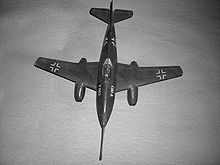50 mm MK 214 A cannon
The 50 mm MK 214 A cannon was an on-board cannon developed for bomber defense for the Messerschmitt Me 262 jet fighter . By the end of the war, only two Me 262s were equipped with this cannon.
Emergence
At a conference in early January 1945, Adolf Hitler pointed out that aircraft with a powerful weapon would be needed to defend against the Allied bomber groups. However, this weapon should have such a large range that it could be used outside the range of the defensive armament of a bomber. During the meeting, an already existing 50 mm cannon was suggested for installation in the Messerschmitt Me 262 jet fighter. Hitler took up this proposal and demanded that it be carried out immediately.
development
The development basis for the 50 mm MK 214 A was the 5 cm PaK 38 ( anti-tank gun ), which was already used as the Kwk 39 (combat vehicle gun ) . When a heavy-caliber aircraft cannon was required in 1944, the 50 mm BK 5 was developed from the Pak 38 at the Rheinmetall company (this was installed in the Me 410 , among other things ) and the 50 mm MK 214 A at the Mauser company .
After several attempts, including with the 50 mm BK 5 , the 50 mm MK 214 A V2 cannon with automatic loading device was installed on March 11, 1945 in a Messerschmitt Me 262 A-1a.
The bow was converted to accommodate the on-board cannon, the normal armament (4 × 30 mm MK 108 ) was removed and the nose wheel was modified to allow it to retract flat (rotated by 90 °) below the cannon. The gun then protruded about two meters above the nose.
This variant of the Messerschmitt 262 was named Messerschmitt Me 262 A-1a / U4. The first flight of the prototype (W.Nr. 111899) took place on March 19, 1945.
During the factory tests, in addition to the flight tests, target exercises with the on-board cannon were also carried out. Satisfactory results were achieved both on the ground and in the air.
commitment
Then the prototype was handed over to Jagdverband 44 , where the machine was flown by Major Wilhelm Herget . During the only use of this Me 262 A-1a / U4 on April 16, 1945 against Allied bombers , the on-board cannon failed due to a jam.
End of war
This only aircraft flown in action was blown up at the end of the war. The second test aircraft (W.Nr.170083; identification: V 083) with a 50 mm Mk 214 A was captured by advancing units of the American armed forces on the Lechfeld airfield at the end of April / beginning of May 1945 and was initially nicknamed "Wilma Jeanne "which was later changed to" Happy Hunter II ". The machine was transferred from Lechfeld to Melun by the test pilot Ludwig Hofmann as part of Operation LUSTY . During a later transfer flight to Cherbourg , the machine crashed due to a turbine fire. Hofmann was able to save himself with the parachute . Another Me 262 A-1a / U4 was still being converted at the end of the war and was captured by British forces in Augsburg .
Another variant
In the search for an effective anti-aircraft gun in the so-called intermediate caliber (between 3.7 cm and 8.8 cm) for the altitude range between 1500 and 3000 meters, it was decided at the end of 1944 to use the MK 214 A as such. To do this, it should be inserted into the modified mount of device 58 . The Dürkopp company in Bielefeld received the development contract at the beginning of 1945 . However, no more 5 cm Flak 214 was completed by the end of the war .
Technical data of the 50 mm MK 214 A
- Manufacturer: Mauser
- Caliber : 50 mm × 420 mm
- Mass: 490 kg
- Total length: 4.16 m
- Rate of fire : 150 rounds / min
- V ° of the projectile: 920 m / s
- Bullet weight: 1.54 kg
swell
- The German special forces. Neuer Kaiser Verlag, 2003, ISBN 3-7043-5036-2 .
- Creek Smith: Me 262 Test and Operation. Heel Verlag, 2001, ISBN 3-89880-016-4 .
- Chamberlain Gander: Encyclopedia of German Arms. Motorbuch Verlag, 1999, ISBN 3-613-01975-2 .
- Jim Winchester: Fighter jets. Parragon, ISBN 1-4054-4940-3 .
- Wolfgang WE Samuel: American Raiders. The Race to Capture the Luftwaffe's Secrets. The University Press of Mississippi 2004.
